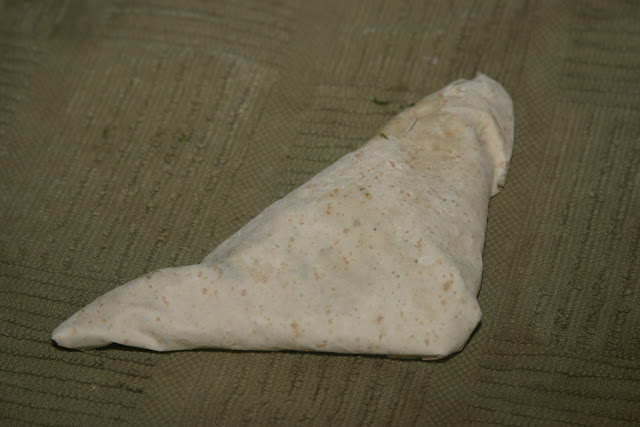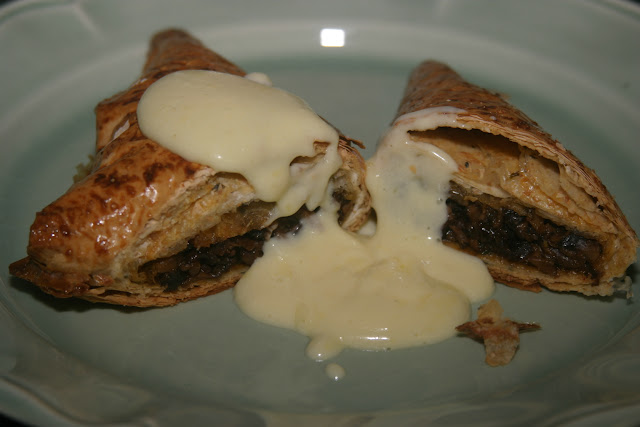
If you like mushrooms, here’s a little dish that will make you love them. If you love them already, then get ready to absolutely adore them, as I think this dish really highlights their earthy, savory flavor. I discovered it many years ago at what was then Dallas’ best brew pub, the Routh Street Brewery. Their mushroom strudel was my favorite appetizer, and after they closed their doors, I resolved to try to make it at home. After years of this, I’ve come close, but I still haven’t precisely duplicated that tasty tart that Routh Street produced. Oh well, I’ve just got to keep trying.

I originally made it as a true strudel, that is, rolled up in phyllo dough. But if you’ve ever worked with phyllo dough, you know what a nightmare it can be to work with. It flakes, cracks, tears and just plain doesn’t want to cooperate with your best efforts to mold it into shape. And then, at serving time, you’ve got to cut it into individual servings, and I found it would often crumble to pieces. So the last few times I’ve made this one, I’ve tried a new approach, and made little individual mushroom turnovers, folding the phyllo dough into little triangles filled with the mushroom mixture. This has worked well, and it has the added benefit that it is easy to serve.
Mushroom Strudel
2 Tablespoons butter
1/4 cup olive oil
1 large shallot, minced
2 cloves garlic, minced
1½ - 2 pounds assorted wild mushrooms, such as Shitakes, oysters, morels, etc, chopped
Tablespoon paprika
teaspoon balsamic vinegar
teaspoon worcestershire sauce
Salt and white pepper, to taste
8 Tablespoons mixed minced fresh thyme, tarragon, parsley and chives
1 large egg
Frozen Phyllo Dough, thawed
1/4 cup melted butter
Melt the 2 tablespoons butter with the olive oil in a large pan over medium-low heat. Add the shallot and garlic and saute until soft, 2 to 3 minutes. Chop the mushrooms to a fairly rough consistency, as below:
This time I have used a mix of shitake, crimini, bella and white, but I've also thrown in this oddball from the shelves of Whole Foods:
The name of this one escapes me.
(Ed. It's called a White Beech Mushroom) But the point is, any blend of four or more wild mushrooms will make for a tasty strudel.
Add the mushrooms and raise heat to medium. Season with the paprika, salt and pepper, and cook, stirring occasionally. Stir in six tablespoons of the herb mixture and the balsamic vinegar and worcestershire.
Stir the herbs in with the mushrooms, remove from heat and let cool slightly.
Preheat oven to 400 degrees and grease a baking sheet.
Spread a sheet of phyllo dough on a work surface, fold it in half. Working quickly, spread some of the melted butter on it and sprinkle a few of the remaining herbs onto this. Place a large spoonful of the mushroom mixture at one end of the dough, and fold over in a triangle.
Phyllo dough is paper thin and comes frozen, rolled up in wax paper, like here. Make sure to thaw it out in the refrigerator for several hours before you try to work with it. At that point, you can unroll it and spread an individual sheet out easily.
Fold the sheet in half and brush some of the melted butter and herbs onto it.

Spread some of the mushroom mixture on one end, then roll it up like a flag.
So that it makes a nice little trianglular pastry, like below.
Place this on the baking sheet, and repeat until you have used up all of your mushroom mixture.
Next, crack the egg into a small bowl and blend the white and yolk together. Use a basting brush and coat the outside of each strudel with the egg wash. Bake until golden brown all over, around 12-15 minutes.
Voila, beautifully baked Strudels
Serve them as is, or with a savory sauce, such as a creamy mushroom sauce. Here, we've served them with a nice
bearnaise sauce.
Until next time,
Happy 'Shrooming,
Chris



































